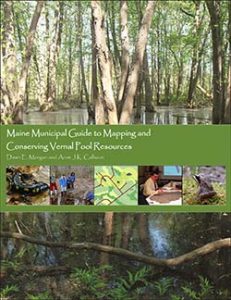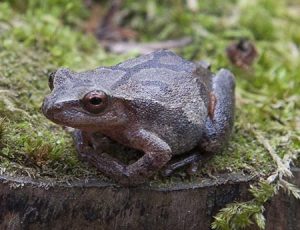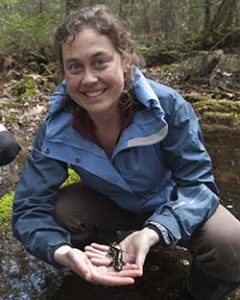Vernal Pool Guide and Pool Hopping
New Guide Helps Towns Identify, Map and Assess Vernal Pools
 Best practices from the Maine Vernal Pools Mapping Project are now available to all towns through The Maine Municipal Guide to Mapping and Conserving Vernal Pool Resources, co-written by SSI research associate Dawn Morgan and Aram Calhoun and published this spring. This comprehensive guide covers everything from vernal pool ecology to training citizen scientists how to identify and assess vernal pools. For more information, visit http://www.umaine.edu/vernalpools/.
Best practices from the Maine Vernal Pools Mapping Project are now available to all towns through The Maine Municipal Guide to Mapping and Conserving Vernal Pool Resources, co-written by SSI research associate Dawn Morgan and Aram Calhoun and published this spring. This comprehensive guide covers everything from vernal pool ecology to training citizen scientists how to identify and assess vernal pools. For more information, visit http://www.umaine.edu/vernalpools/.
Pool Hopping: Solving a Mystery of Amphibian Ecology
Juvenile wood frogs are the long-distance travelers of their species, keeping the gene pool healthy as they journey a half-mile or more from the vernal pools where they were born in search of suitable habitat to begin their lives on land. Increasingly, however, these froglets must traverse a landscape altered by humans.
 Britt Cline, a PhD student working with UMaine wildlife ecology professor Mac Hunter, is studying how forestry, agriculture and suburban development affect the dispersal of juvenile wood frogs. Her findings will yield information that could be used by municipal officials, regulatory agencies, landowners and others to more effectively manage land and habitat around vernal pools.
Britt Cline, a PhD student working with UMaine wildlife ecology professor Mac Hunter, is studying how forestry, agriculture and suburban development affect the dispersal of juvenile wood frogs. Her findings will yield information that could be used by municipal officials, regulatory agencies, landowners and others to more effectively manage land and habitat around vernal pools.
In central and mid-coast Maine, wood frogs typically use three kinds of habitat—the pools for breeding, forested wetlands for summering, and well-drained upland forests for hibernating—but little is understood about how land use practices affect their ability to travel between these places. The movements of the juvenile wood frogs are particularly difficult to study because they are forest-floor brown and tiny—about the size of a human’s pinky fingernail.
Cline is collaborating with Nuri Emanetoglu, an assistant professor in the UMaine Dept. of Electrical and Computing Engineering, and Herb Aumann of Lincoln Labs at MIT on an ingenious way to solve this problem. They are tracking the movements of these tiny frogs across various landscapes by fitting them with harmonic radar transponder tags, an adaptation and miniaturization of the technology used to find lost golf balls. Their findings also could be used to study the movements of other small creatures throughout seasons and years because of the long lifespan of the tags.
 Cline’s early findings suggest a complex picture. She has discovered, for instance, that juvenile wood frogs can quickly disperse through lawns, but may be at greater risk for dehydration and predation as they cross them. Future work will allow her to track individual wood frogs and discover their fates, as well as follow them to their breeding pools.
Cline’s early findings suggest a complex picture. She has discovered, for instance, that juvenile wood frogs can quickly disperse through lawns, but may be at greater risk for dehydration and predation as they cross them. Future work will allow her to track individual wood frogs and discover their fates, as well as follow them to their breeding pools.
Ultimately, this research will shed light on how lawns, hayfields, clearcuts and other land uses affect the ability of juvenile wood frogs to disperse through the landscape. These findings could help address challenges ranging from seasonal land management practices to the improvement of vernal pool buffers that better connect and protect crucial habitat for pool breeding amphibians.
